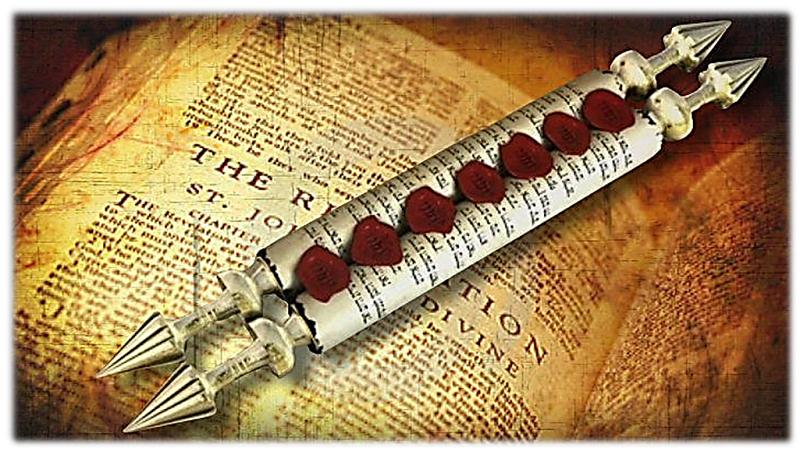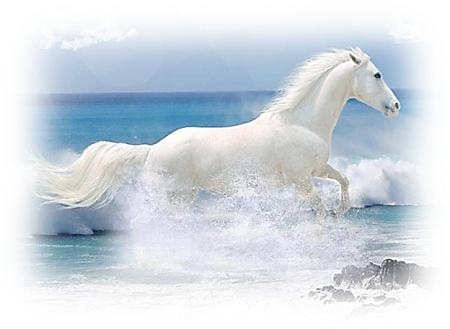Revelation 6: The Four Horses
Revelation 6: The Four Horses
 ⤒🔗
⤒🔗
The Opening of the First Four Seals←⤒🔗
The book of Revelation relates to us the vision which Christ Jesus gave to His apostle John on the island of Patmos to show the churches what soon was to take place and to encourage them and strengthen them in their faith.
In chapter 5 we read how the ascended Saviour receives the scroll that was sealed with seven seals. This scroll is later called the Book of Life of the Lamb. It contains the names of God's elect who Christ as the Lamb of God bought with His blood.
Chapter 6:1-8 speaks about the Lamb opening the first four seals. It is remarkable that the text does not speak of a breaking of the seals and an opening of the scroll, but speaks constantly about the opening of the seals, this points out that the seals have their own contents. When the Lamb, who is at God's right hand as the King of kings and the Lord of lords, opens a seal, its contents is realized, and what it says happens.
The first four seals form a unity. They bring four judgments of God over the earth. Four horses appear, with their four riders. Not all exegetes agree that these four horses belong together. Many separate the first one from the three other ones. They see in the white horse and its rider in white a picture of the gospel of Christ Jesus as this is conquering the world, while the other three bring wrath. Arguments for this interpretation are, among others, that Revelation 19 also speaks of a rider on a horse in white; that white is the colour of purity and victory, that in the Old Testament a bow can be the weapon of victory of God over his enemies (Psalm 7:12,13).
This sounds good and comforting, for it means that before the judgments come there is first of all for the church the comforting message that the gospel goes its victorious and conquering way through the world in spite of all the resistance.
However, there are a number of stronger arguments that speak against this interpretation. Simple reading of the verses 1-8 gives the impression that the four horses and their riders belong together and form a unity.
This is confirmed by the fact that Revelation works strongly with symbolic numbers. One of the main numbers is seven. Seven is often broken down into 4 and 3. We see this in chapters 1 and 2. At the end of each of the seven letters we find an exhortation and a promise. The exhortation is constantly the same: "He who has an ear, let him hear what the Spirit says to the churches." The promise differs. Now it is so that with the first three letters the exhortation proceeds the promise, while with the last four the exhortation is placed at the end. In chapter 8 the first trumpets again form a unity, separate from the three others. This favours an interpretation which takes the first four seals together.

A third argument comes from the Old Testament. For a right understanding of Revelation one needs the first part of the Scriptures. In Jeremiah 15:3 we read:
Thus says the LORD: Those who are for pestilence, to pestilence, and those who are for the sword, to the sword; those who are for famine, to famine, and those who are for captivity, to captivity.
Another text that can help us is Ezekiel 5:17, where the LORD says, "I will send famine and wild beasts against you (Israel) and they will rob you of your children; pestilence and blood shall pass through you and I will bring the sword upon you, I the LORD have spoken."
The last text that I shall quote in full is Ezekiel 14:21. Here we read, "For thus says the LORD God: How much more when I send upon Jerusalem my four sore acts of judgment, sword, famine, evil beasts, and pestilence, to cut off from it man and beast!"
I may further refer to Jeremiah 14:12 (sword, famine, pestilence); Ezekiel 5:12 (a third part will perish by pestilence and famine; a third part by the sword, and a third part will be scattered); 33:27 (sword, beasts, and pestilence). Although not always four elements of judgment are mentioned, the similarity is striking. We see this even more clearly yet when we read Revelation 6:8, a statement in which a summary is given of the verses 1-8a: "and they (the riders) were given power over a fourth of the earth, to kill with sword and with famine and with pestilence and by wild beasts of the earth." We can conclude, then, that it appears to be better to see the four horses and their riders as a unit of four judgments.
The First Horse and its Rider: World Empires←⤒🔗
The first horse was white. White was the colour of victory in those days. The rider had a bow in his hand and a crown (of victory) was given to him. He went out conquering and to conquer. We have here the picture of a world conquerer and empire builder. (In Psalm 11:2 and 37:14 the wicked bend their bow.) Such empire builders, as Nebuchadnezzar of Babylon, Alexander the Great of Macedonia, Caesar Augustus, Napoleon of France, Stalin of Russia, Hitler of Germany are compared with wild beasts, see e.g., Daniel 2, Revelation 13. They conquer and lead into captivity; they build on blood and bring great misery on many nations. They are one of the judgments of God.
The Second Horse and its Rider: Revolution and Civil War←⤒🔗
The second rider was sitting on a red horse. Red is the colour of blood. This rider was given to take the peace away from the earth, so that men should slay one another; for this purpose he received a great sword. With the sword and his red horse this rider symbolizes the scourge of revolution and civil war, which murder their victims by the millions. One needs only to think of the French Revolution that began in 1789, the Russian Revolution which started in 1917, the Communist Revolution in Vietnam and in Cambodia, and immediately one is reminded of the millions of people who lost their lives. Also here we have to do with judgments of God.
The Third Horse and its Rider: Famine and Luxury←⤒🔗
The third horse, appearing at the opening of the third seal, was black. Its rider had a balance in his hand. He announced: "A quart of wheat for a denarius, and three quarts of barley for a denarius." This is indication of poverty and famine. A quart of wheat is the amount which an adult needs for his daily food ratio. A denarius is the normal wages of a labourer for a long day of work (Matthew 20:2). In other words, the man earns hardly enough for himself, leave alone for his family. Wheat was for human consumption, while barley was considered food for animals. For a day's work one could buy three quarts of barley, about enough for the labourer himself, for his wife, and, let us say, for two small children. Over against this poverty the picture shows great riches. These riches are pointed to with the words: "Do not harm oil and wine." Oil and wine were luxury articles. Is there not constantly, throughout the ages, poverty and famine on the one hand while there is, at the same time, great wealth and luxury on the other hand? So we see clearly a third form of judgments of God.

The Fourth Horse and its Rider: Pestilence←⤒🔗
Then the Lamb opened the fourth seal. A fourth horse came out. Its colour was pale. The name of its rider was death. And Hades followed him. This fourth horse and its rider represent pestilence, pointing to diseases that strike mankind as a fourth category in the judgments of God. Illness and disease have killed many many thousands of people. There was e.g., the scourge of the plague in the Middle Ages. One of the concrete judgments here is AIDS.
These four scourges for the earth, especially for mankind, form God's judgments. They are the vehicles of God's wrath that comes upon a mankind that refuses to repent from sin and does not want to believe in God and live in obedience of faith. These four forms of judgments make the wrath of God against sin and lawlessness manifest for those who have eyes to see. God's complaint is: and they did not repent of their deeds and give glory to God (16:9,11).
The comfort for the church, for those who believe in Christ Jesus as their Saviour, is that for those who believe in Christ the wrath of God will be taken away. That is why there is the constant call of the gospel to live out of faith, in communion with Christ. Those who live out of faith will conquer the adversary Satan "by the blood of the Lamb and by the word of their testimony" (12:11).

Add new comment